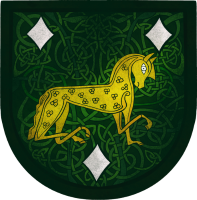After taking a class on natural dyeing using different yellows and indigo in May 2019 at Maryland Sheep and Wool, I decided it was finally time to dye the Romney fleece I bought in 2017. However, I wanted to test sun-colorfastness first, as I had noticed some garments that I dyed with commercial dyes were fading significantly after 2 years of SCA wear and washing.
I decided I wanted to test weld, madder, and indigo (the great triumvirate of medieval dyes) plus cochineal; I also wanted to test these dyes in combination.
Dye Combinations |
||||
|---|---|---|---|---|
| Weld | Madder | Cochineal | Indigo | |
| Weld | X | X | X | X |
| Madder | X | X | ||
| Cochineal | X | X | ||
| Indigo | X | |||
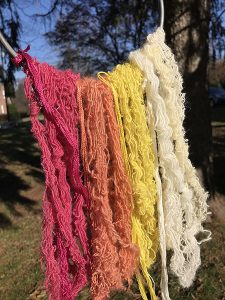
Materials
If I was going to do four different dyepots, I didn’t want to do them for just a handful of spun samples. I pulled commercial linen fabric, silk fabric, and silk thread to accompany the wool. Overall, my materials are:
- Wool (Romney fleece)
- Handspun (full locks and partial locks)
- Washed locks
- Linen
- Fabric purchased from Dharma Trading
- Silk
- Fabric purchased from Dharma Trading
- 2/20 thread purchased from Eowyn de Wever on Etsy
For the wool, I decided to dye both locks and spun yarn. The majority of the yarn was handspun worsted from full locks. However, I spun some woollen out of just the white roots and just out of the yellow tips to test less extensively than the rest of the wool. All of the wool was spun on a spindle.
Fiber Preparation
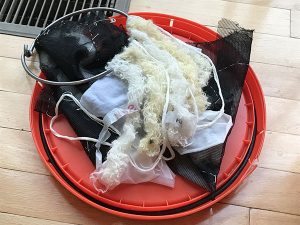
I scoured all the commercial samples with Synthrapol in an enameled pot that has a dent exposing some of the steel. I then cold-soaked all the fibers in alum (aluminum sulfate) at 12% WOG (weight of goods) for around 23 hours in a plastic tub.
My water is pH neutral.
Dyeing
Unless otherwise noted, all items in this experiment were dyed in an enameled pot with a dent (exposing a small surface area of steel) on a gas stove. A draining rack was included with the weld and madder, but after it left marks on some of the items during the madder dye, it was removed.
Weld
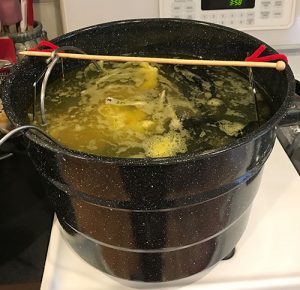
Dye: 3% WOG of a powdered extract.
Process: Put in at 3:34 PM at 81F. Raised the temperature to 180F on medium-high heat over one hour. Turned off, left to cool, and then rinsed in cool tap water.
Madder
Dye: 20% WOG of ground root
Process: Put in at 7:39 PM in tap-hot water (118F) on medium-high heat. Raised the temperature to 180F over 40 minutes. Left to cool overnight. Goods removed at 10:14 AM but were too orange. Added household ammonia to get a pH of 10. Goods re-added and reheated to 170F. Turned heat off and left in dye for over 24 hours, then rinsed in cool tap water.
Cochineal
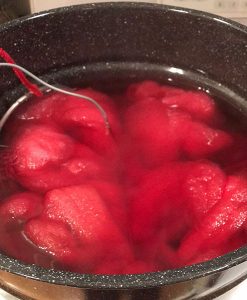
Dye: 100% WOG
Process: Cochineal were hand-ground and soaked in a glass vessel overnight (read: “Don’t touch the bug-juice in the stein!”). They were then strained through an old tea sock, which was tied up with a pipe cleaner and put in the dye pot with the strained liquid and additional water. This concoction was put on high heat until simmering, then held at simmering for 20 minutes. The bug packet was then squeezed and removed and the pot was filled further with hand-hot water. The goods were put in at 120F on medium-high heat. Heat was raised to 160F, then 1 tsp cream of tartar was added and stirred (because I forgot it earlier). I continued raising the heat to 180F, turned the heat to medium-low, and left it covered for 20 minutes. I then turned off the heat and left it for 75 minutes. I put in additional goods to absorb dye (spare roving), raised the temperature back up to 180F, then immediately turned it off and left it to cool for 5 hours. The goods were cooled and then rinsed.
Indigo
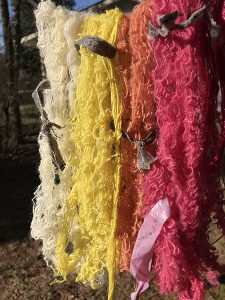
The indigo was done at a dyeing day run by Gusukuma Kame. The indigo was pre-reduced crystals with tap-hot water, dyed outside. All goods were soaked in cool water, dipped once in the indigo, hung up to drip, and then rinsed in citric acid. Because I was still getting a lot of crocking after the citric acid rinse, I also did an extensive rinse (possibly an over-rinse) in Synthrapol.
Finally: Timing!
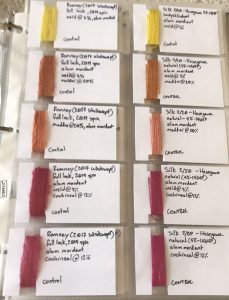
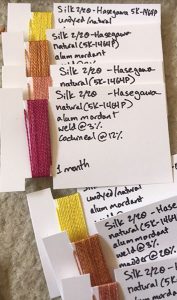
When I decided that I was testing sun-fading, I decided wanted to do it right: over multiple periods of time. Thus, when I put together my goods for dyeing, I pulled enough to have sun-testing lots of each combination for these times:
- 1 week (June 13 – June 20 or June 20 – June 27, depending on predicted sun)
- 1 month (June 1 – June 30; may include the yellow-only dyed wool, the white-only dyed wool, and undyed wool)
- 3 months (April 24 – July 24, centered around Midsummer)
- 6 months (March 15 – September 15)
- 1 year (January 1 – December 31)
All of these lots will be put in a south-facing window. I also put together a dyed control lot and an undyed control lot to keep out of the sun.
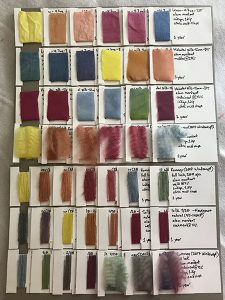
Takeaways Thus Far
- I liked the results of dyeing the wool and silk the best, as the color was richest on these dyes and weakest on the linen (as expected — protein fibers take dye better than cellulose fibers).
- The wool locks took the dye more evenly than thread/yarn and fabric (thus the saying, “dyed in the wool!”).
- Weld is my favorite dye! It’s reliable and consistent.
- For the madder, I should have used 50-100% WOG with the ammonia immediately added to get a stronger red (I want to do a dye experiment focused solely on madder now, playing with pH and dye exhaust!).
- The madder and weld is kind of an ugly rusty orange that I don’t like very much.
- I love the color I got from cochineal, but I went completely overkill on the percentage and overpowered the weld overdye (however, there was still a subtle difference!).
- When you iron cochineal, it turns lavender (until it cools off and returns to the original color)
- I think I overdid the Synthrapol rinse on the indigo, but proving that will require more indigo dyeing.
- The yellow tips on the wool locks absorb the dye less evenly. The most significant example of this was on the cochineal/indigo locks: the main body of the lock was purple, but the tip remained deep magenta!
